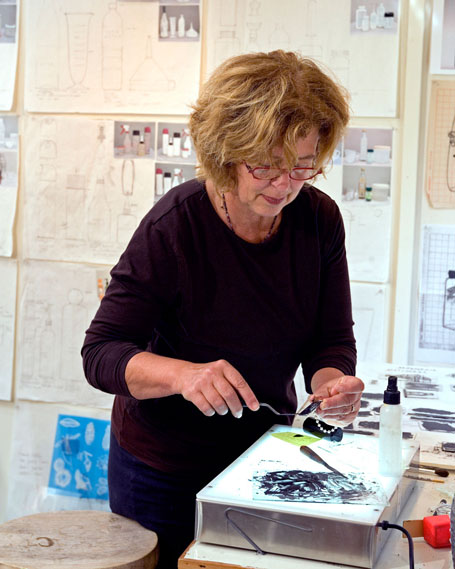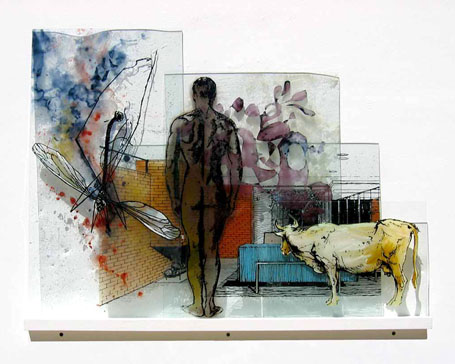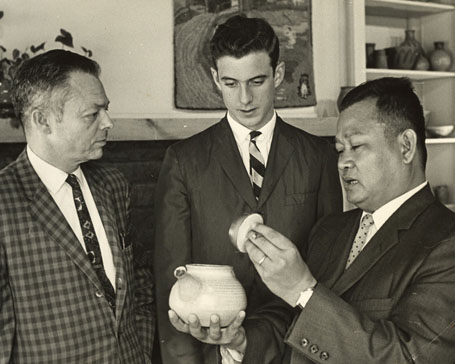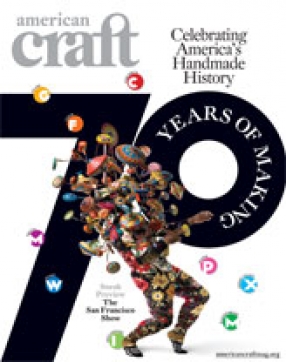


“I have a really strong community up there,” Susan Stinsmuehlen-Amend says of her decades-old ties to the Pilchuck Glass School in Stanwood, Washington, which recently honored her with its 2007 Libensky Award for contributions to the glass field. “They were the first people to say to me, ‘You’re really doing something different and important.’” Active for years in the glass community (she was the first woman president of the Glass Art Society), Stinsmuehlen-Amend jokes that she “disappeared” in 1994 to Ojai, California, where she still lives with her husband, Richard Amend, an artist and film production designer (the younger of her two sons just left for college).
She always considered herself a painter on glass, but used to mix media, in part to avoid identification with traditional stained glass: “I was in a rebellious state.” Her work these days is “pretty glassy. I feel like now I’m being true to the material, really enjoying the subtlety, beauty and difficulty of working with glass paint.” It’s still edgy, with imagery drawn from everyday life–her old desk-calendar doodles (“icons of the subconscious”) or “common vessels” like a turpentine can. “I guess I’m still rebelling against the material. I’m taking tradition, and twisting and turning it.”
Now in its fifth year, Collect has firmly established itself as the go-to place for novice and seasoned collectors alike, to see and buy the best in contemporary craft from over 40 galleries throughout the U.K. and Europe (plus a few from Japan, Australia and the United States). Britain’s Crafts Council presents the fair January 25-29 at the Victoria & Albert Museum, London.
Beyond cut and paste, the Creative Child Center Pre-school at the Wichita Center for the Arts, Kansas, is based on the premise that making art and music enhances cognitive development. “It’s a great way for children to learn, because it stimulates their thinking and allows them to use their own resources to gather information,” says the school’s director, Wayna Buch. “In the process of creating, they come to understand the process of learning. That’s the key.” Along with plenty of paint and Play Doh, there are visiting artists and field trips to the Wichita Center galleries, where the kids have their own show in December.
Since 1925 the Textile Museum in Washington, DC, has celebrated its subject as art and cultural artifact. Now there is expansion news: a second site, set to open in early 2008. McInturff Architects is designing the 23,400-square-foot space in a 1917 building downtown, near Smithsonian museums and the National Mall.
Robert W. Gray , who led the Southern Highland Craft Guild from 1961 to 1980 and created its popular Folk Art Center in Asheville, North Carolina, died August 10 at the age of 91. Gray was widely respected for his work in promoting western North Carolina as an internationally recognized center for craft, a mission he shared with his wife, Verdelle. He was a Fellow of the American Craft Council, and a recipient of the state’s prestigious North Carolina Award in the Fine Arts.
Located in Lybster, a small fishing village on the northeast coast of Scotland, North Lands Creative Glass bills itself as that country’s “centre for excellence in glass making.” A worthy claim, given the caliber of participants at its international conference, “Expression of Self,” in September, which featured master classes and talks by guest visual artists Judith Schaechter, Clifford Rainey, Silvia Levenson, Bruno Romanelli, Emma Woffenden, Gareth Noel Williams, Shona Illingworth, and Einar and Jamex de la Torre; Ashley Page, artistic director of the Scottish Ballet; and Dr. Martin Conway, director of the In-stitute of Psychological Science at the University of Leeds. For info on its artist residencies and other programs.
Judaica Silversmithing, the only program of its kind in the United States, celebrated its 20th season at the 92nd Street Y, in New York City, this past fall. Part of the Y’s Jewelry and Metalsmithing Center, the program teaches adult students how to craft ritual objects central to Jewish life—Kiddush cups, menorahs, Shabbat candlesticks, Seder plates, among others. Devotees of the course spend several hours a week designing and hand-building their pieces, working primarily with silver, but also with copper, gold, bronze, wood and semiprecious stones. The program originated in 1956 at the nearby Jewish Museum, and was shaped by the legendary Judaica artists Ludwig Wolpert and Moshe Zabari, noted for bringing clean modernist design to Jewish metalwork which traditionally was heavily ornamented. In 1988, when the program relocated to the Y’s well-equipped metalworking studios, Harold Rabinowitz and Bernard Bernstein, master Judaica silversmiths who had studied with Wolpert and Zabari and absorbed the modernist aesthetic in their own work, were chosen to lead the program.






Comments
February 25th, 2008
Hi! Cool!.. Nice work... big hows it going?! missing everyone so much big, THANK YOU
Posted By Julia
Post Your Comment
Fields in bold are required. Your email address is required but not published. Please enter the five digit code as it appears in the text field on its right.